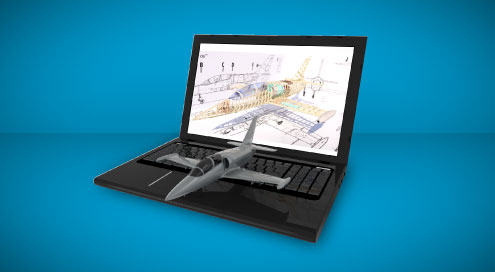Traditional collaboration methods in the product development process are slowly going by the wayside. 2D drawings and pen-and-paper notes are giving way to digital design processes. What’s more – individuals are working with dozens, sometimes hundreds, of people instead of a small handful of teammates. Thanks to today’s technological tools, teams have greater insight into the greater product development process leading to more effective collaboration.
It becomes more critical than ever to maintain a product model’s integrity. Once a model is compromised, collaboration methods break down and the product loses tenability.
Jim Zwica
Less face-to-face collaboration, greater process insight, and the strength of the digital age all impacts the true importance of a 3D product model. Rather than relying on word-of-mouth or institutional knowledge, the model itself becomes the trusted, authoritative source of product definition throughout the PLM process – from design, to as-built, to use, through upgrade.
This means that it becomes more critical than ever to maintain a product model’s integrity. Once a model is compromised, collaboration methods break down and the product loses tenability. To ensure optimal collaboration and a strong product model, forward-thinking organizations rely on three digital approaches to improve 3D product workflows. Although these concepts are still new and aren’t yet optimized to their full potential, their benefits are already proving to have strong impacts on collaboration.
1. MODEL-BASED ENTERPRISE BRINGS AN AUTHORITATIVE SOURCE OF TRUTH TO 3D MODELING
Currently, manufacturers are transitioning away from the traditional application of 2D drawings or paper-based data to make decisions. Instead, they are leveraging a digital model of a physical object for all activities and decision-making. This strategy is known as a model-based enterprise (MBE).
MBE can lead to more easily sustained products, increased savings, and greater collaboration with suppliers and partners.
Jim Zwica
During design, the MBE converges with PLM tools and methods by providing shape, behavior, and context to 3D models. Organizations leverage the 3D models at any point in the PLM process, giving all contributors a secure and authoritative source of product definition required for today’s collaboration needs.
At the heart of an MBE strategy is the model-based definition (MBD). According to MBE expert Nathan Hartman, an MBD is a 3D CAD model with embedded dimension and notation information. An MBD enhances the design process while leading to reduced costs, improved product transparency, and optimized evaluations. To be truly successful, the MBD must include:
- Geometry definition
- Dimensional information
- Design intent clarity
- Explicit information
Adoption of the MBE approach is growing, evidenced most recently by the Department of Defense transitioning to a completely digital strategy. According to Hartman’s recent analysis of the transition, MBE can lead to more easily sustained products, increased savings, and greater collaboration with suppliers and partners.
2. DIGITAL TWINS OPTIMIZE COLLABORATION FROM DESIGN TO MANUFACTURING
In today’s product development process, there is a gap between the “as-designed” and “as-built” steps of the product. Once a product’s design is complete and passed to manufacturing, the teams may make changes to the product without updating the “as-designed” documentation. Discrepancies between the design documents and the finished product create confusion, add work later in the product’s lifecycle, and waste time and dollars.
With a digital twin, an organization can normalize the differences between design and manufacturing which keeps everything consistent across the product lifecycle.
Jim Zwica
Working with a digital twin can help resolve these discrepancies. In our industry, the concept of the digital twin means different things to different organizations, and a clear, concise definition is challenging to find. In my context, a digital twin is a fully integrated model of a physical component including all material data, metadata, context, and behavior. With a digital twin, an organization can normalize the differences between design and manufacturing which keeps everything consistent across the product lifecycle.
Leveraging a digital twin widens collaboration opportunities and oversight into the product’s usage. Remembering that the digital twin creates consistency throughout the lifecycle, comparing a component’s as-designed, as-built, and physical performance enables an organization to:
- Track component variations
- Inform design of next-generation products
- Develop predictive modelling and validation schemes
- Diagnose and resolve issues as they occur
- Access all requirements, concepts, validations, estimated costs, suppliers, service lifecycles, and association with field data in one location
Many believe that the digital twin could be shared with suppliers and outside collaborators, yet there remain many questions about providing access to the data. Combined with a lack of consensus on a true definition for the concept, outside collaboration that is streamlined and reliable is almost impossible.
3. DIGITAL THREAD CONNECTING THROUGHOUT A PRODUCT’S LIFECYCLE
Stemming from the digital twin is a digital thread, a trail that follows a component throughout the product lifecycle. Again, there is currently a lack of consensus in our industry in what comprises a digital thread. According to my friend and PLM expert, Don Haupt, a digital thread at a high-level includes:
- Product strategy and design
- Product development
- Process development
- Physical product execution
- Physical product support, which then feeds back into product strategy and design
Most importantly, the overview described above should not be seen as a linear process or path. Digital threads are cyclical, providing an organization traceability into the product, seen in Figure 1 below:

By following a digital thread, products can be improved based on real-time feedback from the physical product into the digital twin. PLM, the digital thread, and the digital twin enable continuous system, product, and process design and development.
THE NEXT GENERATION OF PLM
Throughout the course of this blog series, we’ve discussed the impact that PLM software solutions have on organizations – for better or for worse, and what the future may hold. The most important thing to remember is that PLM is an approach, with software tools designed to support PLM activities along the way.
According to Automation World, the next generation of PLM will be a product innovation platform that includes suppliers and non-engineers. I believe that changes will happen rapidly, and companies will have to make adjustments based on product demand. Furthermore, I predict that as collaboration needs continue to grow, there will need to be a collaborative visualization effort between engineering, manufacturing, supply chain, and the user. As companies monitor and track a product’s performance, the 3D product model as created by the PLM approach will provide a source of truth.
The most important thing to remember is that PLM is an approach, with software tools designed to support PLM activities along the way.
Jim Zwica
In conclusion, I will leave you with these thoughts from Don Haupt, retired technical steward of PLM and engineering systems at Caterpillar:
“From a process perspective, there has to be a cultural change across the product development industry that truly adopts PLM as a business strategy and understands the impact it can have. This is starting to happen, as some universities are beginning to teach PLM and include it in their core engineering curriculum.
From a technology perspective, PLM systems must have a flexible data model that allows multiple views and uses of the master data from a single source. PLM systems should not allow copies of copies of copies of the same information to be created. It should allow the master data to be presented to the user in multiple ways, depending on what it is they need to see.”



COMMENTS